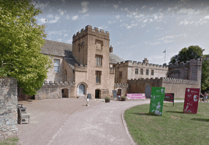TORQUAY’S beloved Britannia is safe and sound – being kept under lock and key at a secret location in the bay.
A statue of Britannia – the iconic female warrior who rules the waves and defends the realm – stood on the very top of the dome of Torquay’s Pavilion for a century before she was taken down.
Britannia looked out over Tor Bay while the building beneath her feet served as a theatre, an ice rink and later an arcade of shops, and campaigners fighting to restore the building feared she may have been lost forever as the Pavilion fell into disrepair.
Now, though, the man in charge of the painstaking Pavilion restoration project has confirmed not only that Britannia still exists, but also that she might one day return to her ‘perch’ on top of the building’s distinctive dome.
In one of six new videos created by Torbay Council, head of engineering Tim Jones reveals: “The fantastic news is that Torbay Council still has Britannia. She’s safe and secure in an undisclosed council location. I’ve been assured she’s under lock and key.
It would be wonderful, at some point in the future, to see her returned to her rightful place atop the dome.”
In the videos Mr Jones and Pavilion project manager Paul Munro show viewers around the Pavilion as the restoration work gathers pace. Government money is being used for the project, and there have been suggestions that the Pavilion could become an Agatha Christie heritage centre in recognition of the Torquay-born author’s legacy and popularity with visitors.
The next phase will involve opening up the existing structure to get a detailed view of its condition after years of neglect.
The worst affected areas are those facing the prevailing south-west winds, where driving rain has got in.
The flat roof that faces the harbour and the green is an area of particular concern.
Metal corrosion has caused ‘ruptures’ in the structure, and some areas have restricted access for safety reasons.
“Unfortunately, the west and south elevations show significant deterioration, but we’re managing it professionally and confidently,” says Mr Jones.
Ornate plasterwork that gave the theatre its distinctive look in its heyday is giving the engineers one of their biggest challenges, and heavy ceiling plaster has become unstable in places.
Some pieces have had to be removed, but they have been photographed and catalogued.
Metalwork in the dome itself is in good condition, and engineers no longer believe the dome will have to be removed temporarily as part of the restoration.
In the videos, Mr Munro says this stage of the project is now in week 14 of 36.
The next step will be scaffolding on the side facing Princess Park to support the building and prevent further movement or collapse, followed by the careful removal of asbestos tiles.
“The entire project team is working closely with specialists in heritage, planning, and design to ensure the building is protected and prepared for its future,” he says.




Comments
This article has no comments yet. Be the first to leave a comment.